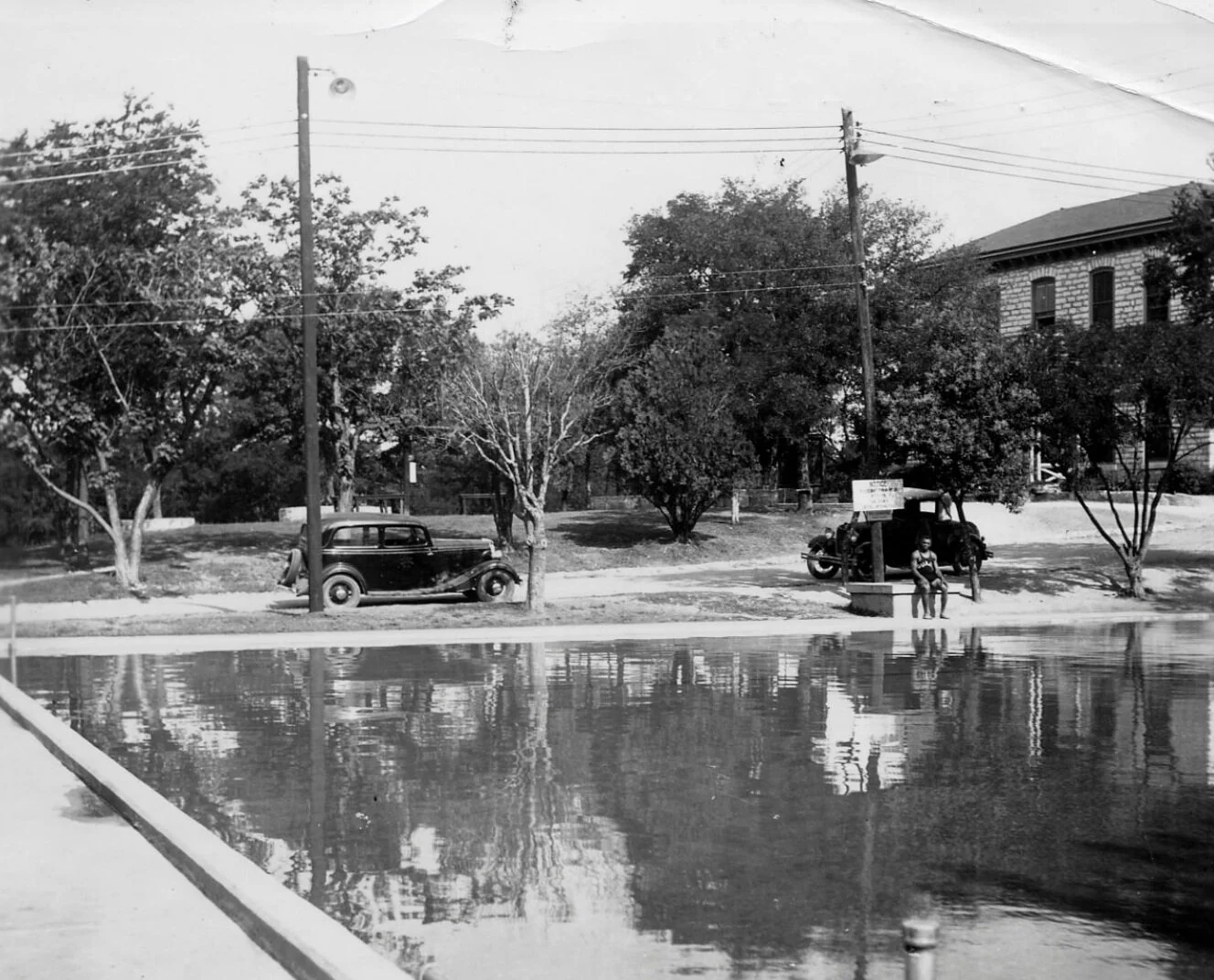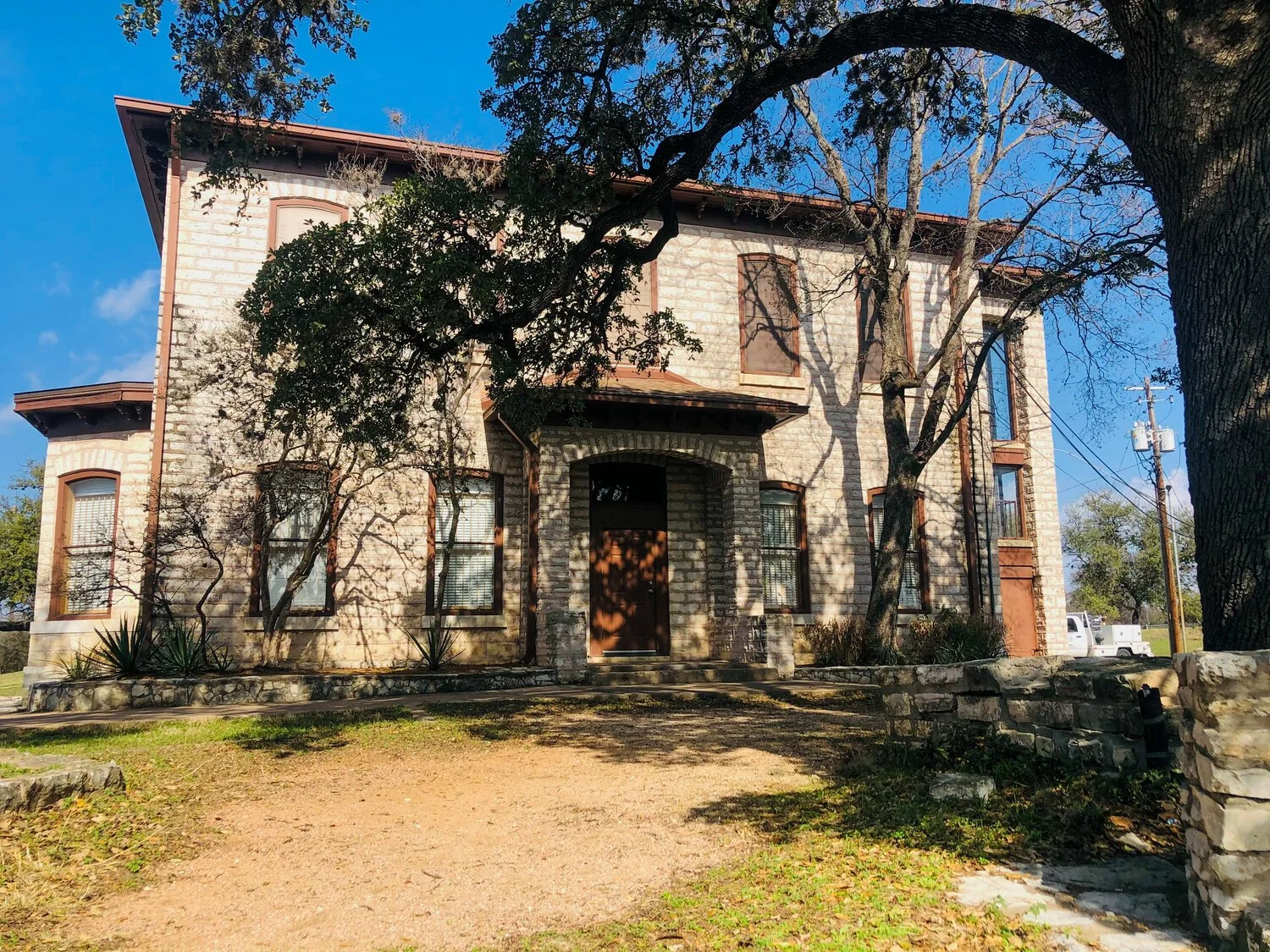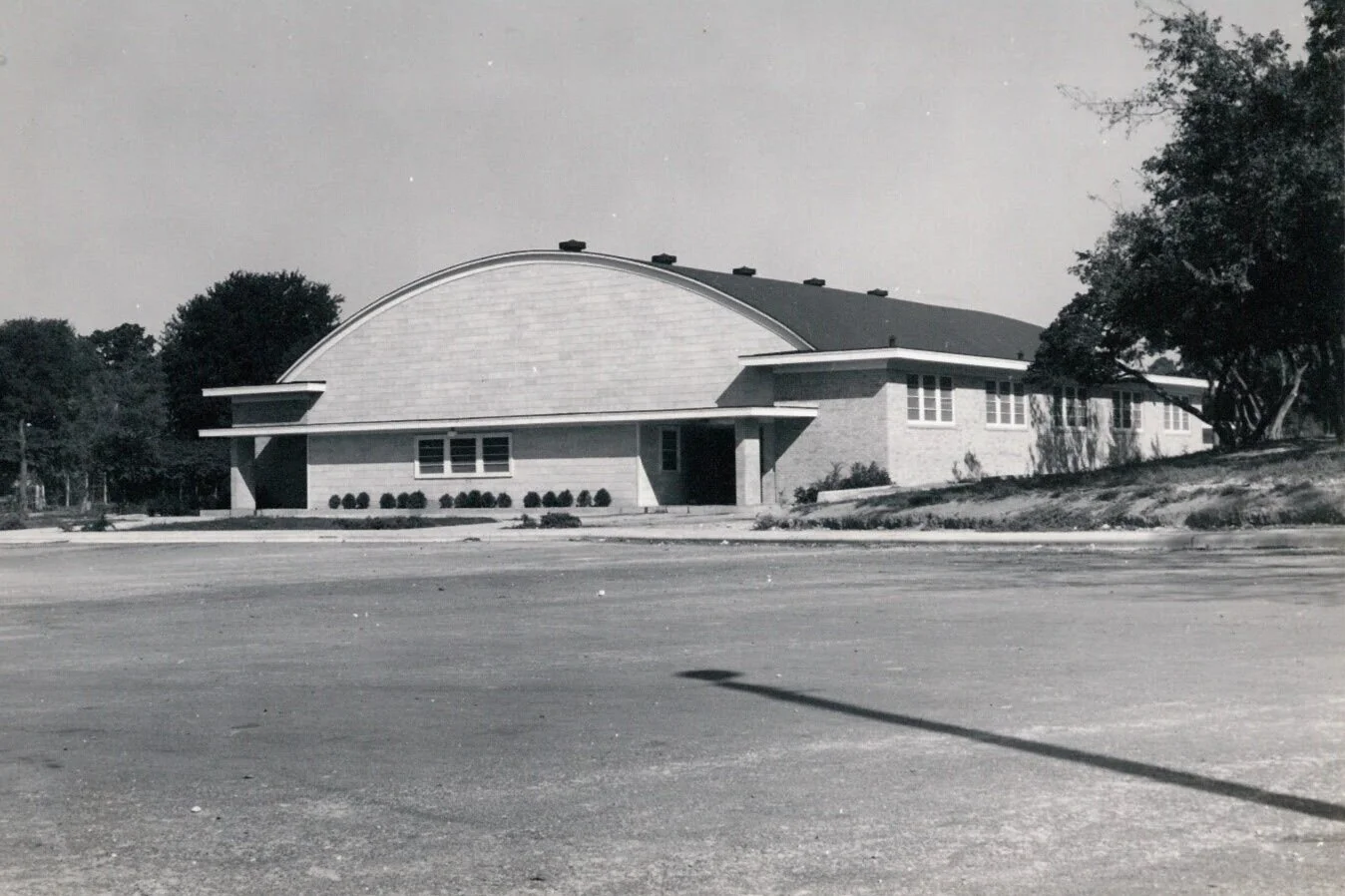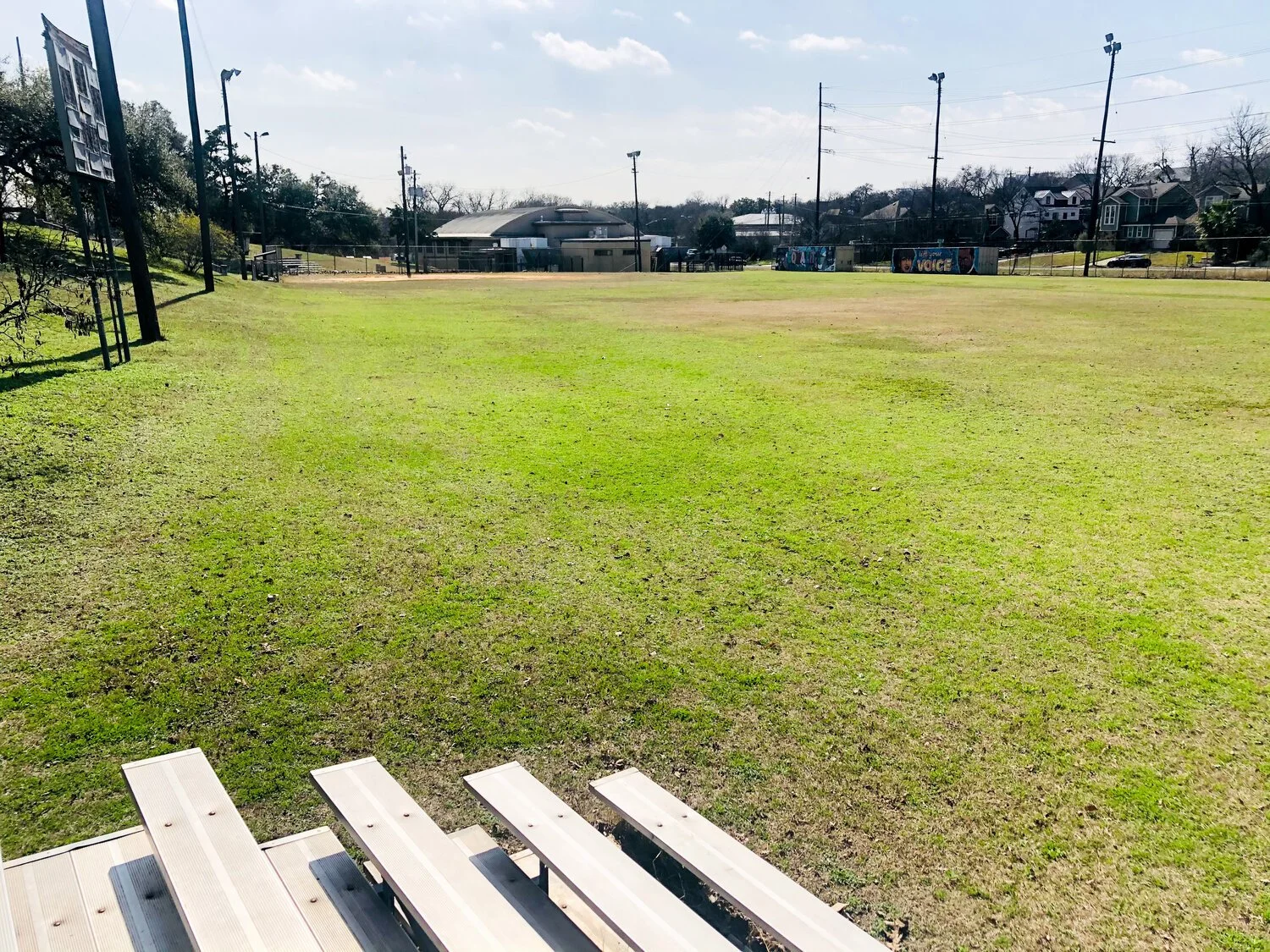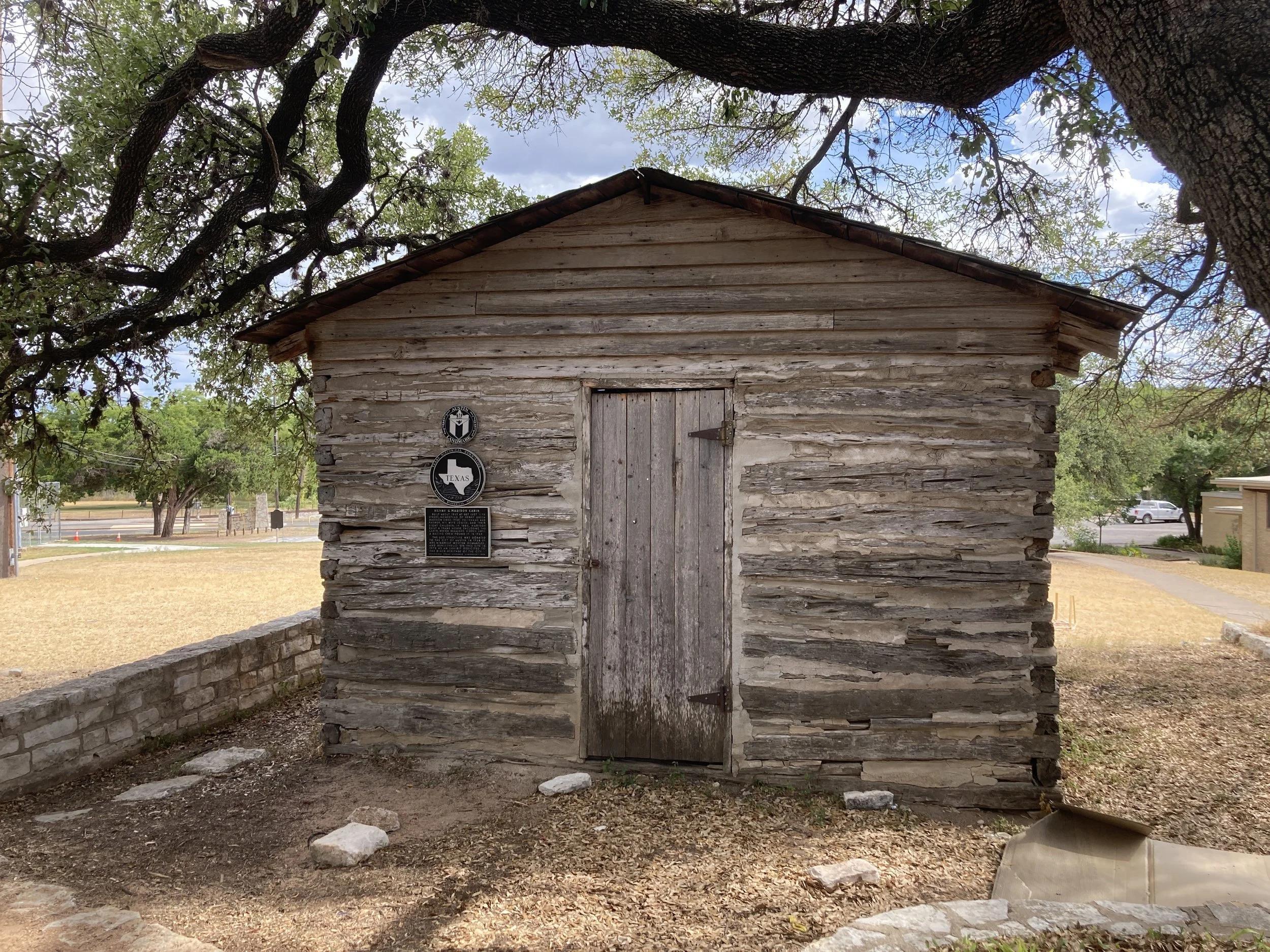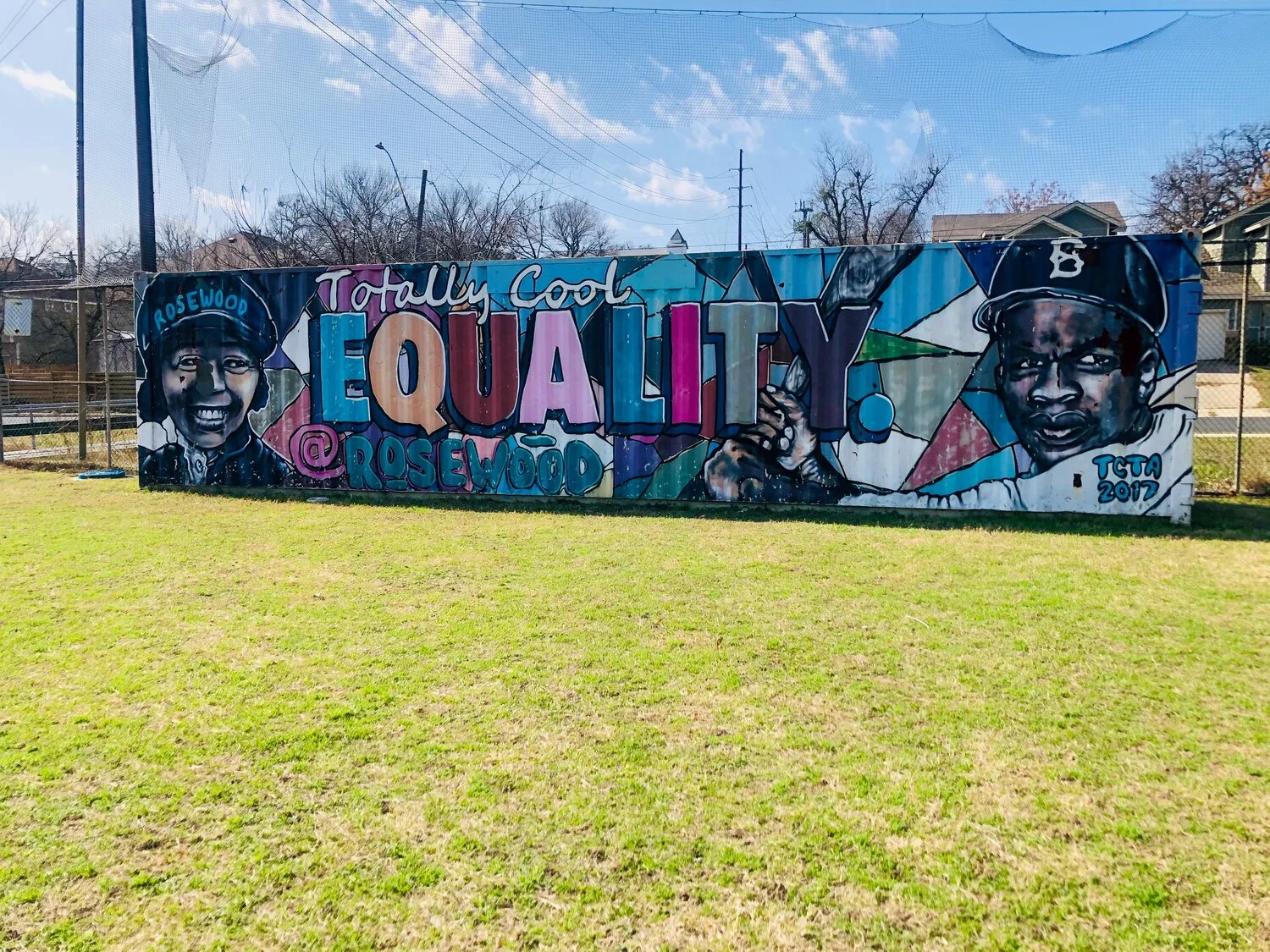Rosewood Park: A Historic Icon of Austin’s East Side
BY SARAH MARSHALL
Children playing in Rosewood pool, 1938, (Austin History Center, Austin Public Library).
Rosewood Park is located along Boggy Creek in the center of East Austin. The land was originally a homestead settled by local storeowner Rudolph Bertram in the 1870s. The city purchased the property in 1928 for $13,500, opening Austin’s first public park for African Americans there two years later. Since its inception, Rosewood Park has served an indispensable role in the lives of the local community and continues to provide the neighborhood with a grand public space for recreation.
1928: A City Plan for Austin, Texas
In 1927, the City of Austin hired Koch & Fowler, a Dallas-based civil engineering firm, to prepare a city plan. Completed the following year, the ambitious effort addressed a wide range of issues, including transportation, schools, public works, land-use, and demographics. Seeking to preserve and capitalize on the city’s inherent beauty, the plan proposed a system of parks and greenbelts along Austin’s creek and waterways, and advocated the creation of new city parks and improvements to existing ones.
Another part of the 1928 plan established a “negro district” to the east of East Avenue (today’s I-35) in the largely industrially-zoned part of the city. At the time, African Americans lived in small numbers across the city with the majority already living in East Austin. Knowing that segregationist zoning laws were illegal, the plan recommended denying basic services and amenities to those living outside of the district. If African Americans wanted public services, such as sewage lines, schools, or parks, they would receive these more readily in East Austin under the “separate but equal doctrine” of the Jim Crow era. The city established the “Rosewood Avenue Park and Playground for the Colored” in East Austin in accordance with the plan. Conversely, it barred public services, including parks, to African Americans living other parts of Austin.
1930s: A Park for African Americans in the Jim Crow South
When Rosewood Park opened in the Summer of 1930, there were many amenities: Located in the center of this tract is a splendid two-story rock building which provides a home for the keeper, with abundant additional room for recreational purposes. A portion of the grounds is covered with beautiful natural growth trees and shrubs and makes an ideal park site. Two large baseball fields, tennis courts and a combination swimming and wading pool have been built and playground apparatus installed (Report City of Austin 1930).
Rosewood Park, 1936,(Austin History Center, Austin Public Library).
The city had immediate plans to renovate the original Bertram house to use as a clubhouse and house for the caretaker, George Mabson. Improvements to the house and site throughout the decade include the addition of stone entry columns, a bandstand, and steps and retaining walls that lead to the sports field. Some of the work was completed by the Civil Works Administration and the Works Progress Administrations as a part of New Deal federal relief programs.
The park quickly became a central location for events for the African American community. Although still celebrated at Emancipation Park and other locations within Austin, the first known year that Rosewood Park hosted a Juneteenth celebration was in 1930. The day’s festivities started with baseball, races, a swim meet, and tennis matches, and the closing celebrations featured community singing and dancing. The following year a basket picnic and live music were added to the schedule. Rosewood Park became the main location for Juneteenth celebrations citywide, and today, though the festivities have changed, it carries on this tradition annually with thousands in attendance.
Bertram House (built in 1875), (Austin History Center, Austin Public Library).
Bertram House, 2021
1940s: WWII on the Home Front
As the U.S. entered World War II in 1941, many servicemen were stationed in and around Austin. The Recreation Department served as the official liaison agency between the military and the community, coordinating all available resources to promote a recreation program for servicemen visiting the city. The Defense Recreation Council was created, and it was segregated just as the armed forces were during that time.
Recreation was provided for white servicemen only until the summer of 1942, when the Recreation Department began hosting weekly dances for African American servicemen at Rosewood Playground. By the end of the year, the dances at Rosewood Park’s community center and tennis courts were extremely well attended as some of the only amusements offered to these soldiers outside of their military bases. Finally, the Negro War Recreation Council was organized late in 1942.
Throughout 1943, thousands of African American servicemen utilized Rosewood Park for sports, dances, socials, picnics, dinners, and sing-alongs. It became clear that they were in need of additional space to accommodate the magnitude of people taking part in wartime leisure. A recreation building designed by architect J. Roy White (1907–1985) opened at Rosewood Park on April 10, 1944 and served as an auditorium and gymnasium originally operated by the USO.
The building was named for Doris “Dorie” Miller (1919–1943), born in Waco, Texas. An important, national figure, Miller was the first African American to be awarded the Navy Cross. Assigned as head cook on the battleship West Virginia, Miller had no weapons training. During the assault on Pearl Harbor, his actions ranged from rescuing wounded sailors to firing antiaircraft machine guns at Japanese aircraft. Miller was eventually promoted to Petty Officer and assigned to the Pacific Theater on the escort carrier Liscome Bay. On November 24, 1943, a torpedo struck the Liscome Bay and Miller was killed along with 645 people. Many feel that Miller should have been awarded the Purple Heart Medal for his actions. His story has been retold in literature and film in the years since his death.
Doris Miller Auditorium, c. 1944 (J. Roy White) (Austin History Center, Austin Public Library).
Doris Miller Auditorium, 2021 (J. Roy White)
The Doris Miller Auditorium was used extensively after it became a recreation center in 1946. The “Chitlin Circuit” is a nickname given to a network of performance venues throughout the U.S. that provided commercial and cultural acceptance for African American entertainers during racial segregation. The Doris Miller Auditorium hosted a variety of African American entertainers during the 1940s through the early 1960s. Famous acts such as Nat King Cole, Louis Armstrong, Count Basie, and Little Richard all performed there.
1960s: Integration of Austin parks
On May 17, 1954, the Supreme Court of the United States ruled on Brown v. Board of Education of Topeka and stated that segregation of “white and Negro children” in public schools was no longer allowed. On November 7, 1955, the Supreme Court upheld a decision outlawing racial segregation in public parks and playgrounds as well, though some Southern leaders declared there would be no mixing of races at public parks, and that they would opt to close the parks instead.
Here in Austin, in 1959 the Recreation Department allowed African Americans to utilize today’s Emma Long Metropolitan Park, located some distance from the city, for picnicking and camping at the swimming area on the Colorado River and the campgrounds. African Americans were also allowed to use the Montopolis Playground and golf at Lion’s Municipal Golf Course. Some of the white parks’ inter-city league teams had African Americans on them, and they were allowed to play.
However, it was not until the summer of 1963 that Austin’s parks quietly integrated. The 1962-63 Recreation Department annual report noted that all summer playground tournaments included Rosewood for the first time in 35 years.
Rosewood Park, 2021.
There was little publicity surrounding the integration of the city’s parks, but that was deliberate:
“In order to allow Austin boys and girls an opportunity to take part in any portion of the program they desired. The inclusion of Rosewood playgrounds in all tournaments offered no problems and Negro boys and girls using other grounds were placed in tournaments as any other youngster trying out for skill recognition.” — City Recreation Director Beverly Sheffield
Very little documentation exists about the integration of Austin’s parks and pools, but a newspaper article from May 1964 states:
“Austin parks, playgrounds, swimming pools, golf courses, libraries and public schools are operated on a non-segregated basis.
Children playing in Rosewood Park, c. 1940s, (Austin History Center, Austin Public Library).
1970s: Henry G. Madison Log Cabin
Born in 1843 in Memphis, Tennessee as a free man, Henry Green Madison made his way to Austin by the early 1860s. He married Louisa Green and built a small cabin at 807 East 11th Street. Madison was a Unionist, president of the Austin chapter of the Union League, and an active participant in Reconstruction. He served as an assistant at the Texas Constitutional Convention of 1868-69, and captain of an African American unit in the Sixth Regiment of the Texas State Guard. Madison is notable for being Austin’s first African American City Council member from 1871 to 1872. He went on to serve as a policeman, porter, and farmer, passing away in 1912. He is buried at Oakwood Cemetery.
In 1968, a demolition crew discovered Madison’s original cabin enveloped in a larger house from the 1880s. The cabin’s exact construction date is not known, but it dates to 1864 at the latest. The owner of the property, Mrs. Greenwood Wooten, worked with the Rosewood Recreation Association and the Delta Sigma Theta Service Sorority to disassemble and relocate the cabin to Rosewood Park in 1973. The Henry G. Madison log cabin became a Recorded Texas Historic Landmark in 1974 and a City of Austin Landmark in 1976.
Madison Cabin, 2022
Rosewood Park Today
The Catherine Lamkin Arboretum Trail of Trees was dedicated in 1995 for a 35-year employee of the Parks and Recreation Department who dedicated her career to recreation programs in East Austin. In 2011 the Britton, Durst, Howard, and Spence Building was named in honor of four distinguished Austin community leaders: Lawrence M. Britton Sr., Reverend Albert Lavada “Dr. Hep Cat” Durst, James Howard, and Donald Joseph Spence. In 2014, the former Bertram house was officially dedicated as the Delores Duffie Recreation Center. Duffie is a lifelong resident of the Rosewood neighborhood, and served as a community activist advocating for people in East Austin. “I always had a thing for Rosewood Park,” said Duffie, who played on the park grounds as a young girl. “That’s all we knew. That’s the only place we had to go for recreation. Rosewood was just in my blood.”
Rosewood Park has remained largely intact since its inception, true to the tenets upon which it was founded. For nearly 90 years, it has endured as one of the only civically-funded recreation areas for an otherwise disenfranchised and under-serviced community. Today, Rosewood Park is a physical reminder of the significance of this public space in the cultural history of Austin’s African American community.
Mural in Rosewood Park, 2021
THIS ARTICLE WAS WRITTEN FOR PRESERVATION AUSTIN’S SUMMER 2019 NEWSLETTER. READ OUR COMPLETE NEWSLETTER ARCHIVE HERE.


